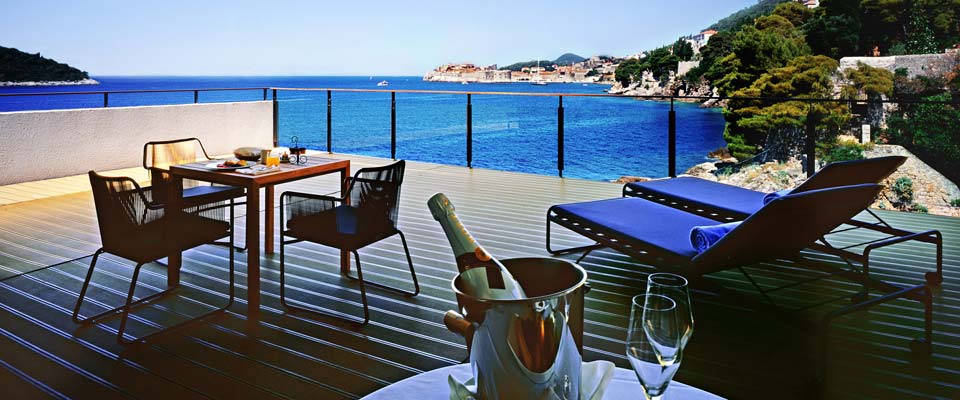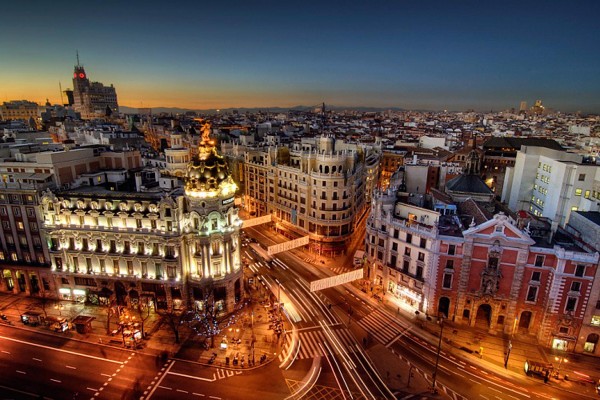Croatia’s fairytale city, Dubrovnik is every bit as enchanting as Paris or Venice. Indeed, the city has slowly become a go-to destination for the au courant, as well as the rich and famous. Our editor, Laith Al-Kaisy, took a seven-day tour of the city to see how the post-war mindset and investment has helped cultivate some of the most indulgent experiences in Europe
Dubrovnik Palace
Straight ahead, beyond the French doors and over the balcony, the edge of Dubrovnik gently falls into the Adriatic Ocean. It’s too dark to actually see, but it’s there. You can hear the water playfully slap the brusque, arid rocks that peg the land’s end. The salty breeze is just enough to ruffle the palms. Above, in the ebony sky, you can play join the dots with constellations and shooting stars. Ink-blot shadows leap around the void like a nocturnal species of their own. And the incandescent moon follows every move, protecting the island with militant heed.
Last time I was here, it was a fleeting, drug-addled haze. Croatia was a hangover cure, a comedown from a four-day romp at Serbia’s Exit Festival. Those were my uni days, where sybaritic holidays like these were as vague and distant as my next bag of weed. But as I step out onto the balcony, the memories begin to sheepishly tug on my sleeve. It may be dark, but that doesn’t matter, because the things that make Croatia so utterly sublime aren’t necessary visible or tangible – they just ‘are’.
Dubrovnik Palace is the perfect introduction to a city that needs no introduction. Likewise, the hotel itself is one of the most well-known in the region, lying recumbent on the westernmost tip, the appendix of Dubrovnik. The area is soporific and sparse, which is fine for me. I prefer the slow acquaintance of travel, the geographical foreplay, not the reckless, head-first, knee-deep stuff. There’s a small beach, a couple of shops, and a few restaurants nearby. Walk an extra 500 metres or so to find anything that resembles proper civilisation – and then, that’s only in the evenings.
The hotel is five-star, but five-star Dubrovnik, which is never going to match the glitzy heights of London or New York. But the suite is certainly spacious and more than enough for someone who is used to top-end hospitality. The design is clean and neutral, very much adhering to the large-hotel aesthetic: light wooden floors, matching veneers, king size bed, comfy armchairs. I much prefer this to chaotic abandon of boutiquey accommodation.
But don’t kid yourself: the large balconies that stare endless into the Adriatic are what you’re paying for here. Indeed, it feels more like an apartment than a hotel room: secluded with no other people or balconies overlooking you.
Below, the beautifully-crafted poolside meets the makeshift shore; you can thaw out your Britishness in the mid-afternoon sun, which hangs intensely in the ultramarine sky. There’s one of those Club Tropicana-esque bars too, so you can sup on some award-winning cocktails whilst working on your George Hamilton.
There are three restaurants to choose from, but Ponta overlooks the ocean and is closest when sunbathing. Lunch options include fresh seafood, meats and salad. It’s not cheap, but then high-end in Dubrovnik isn’t cheap. However, these prices can be relied on for quality ingredients, prepared with the idiomatic passion typically found on these islands.
In terms of service, the staff were there when we needed them, out of sight when we didn’t – as it should be. Dubrovnik Palace gluts the appetite for prestige and charm, and fulfils its role as a solicitous yet unimposing host.
One piece of advice about Dubrovnik: don’t stay at just one hotel, but be sure to check-in at this indulgent and placid retreat. Stand on the balcony and let the memories create themselves.
Villa Dubrovnik
There’s something abjectly lazy, predicable and anti-journalistic about defining Dubrovnik in one word, but I’m going to do it anyway: laidback. This is a community of people who are abundantly vivacious, familiar, carefree and generous. Totally, irrevocably, missionary-sex horizontal. Dubrovnik is unlike any other city, which is why I have grown to love it so much – not just for what it is, but for what it’s not.
The city is instantly prepossessing, a definite tourist destination. And despite being inertly paced, the people are hard working and passionate; a place where a hard day’s work not only feeds the family, but the soul. It’s an ethic that is somewhat passé in the UK, but means the economy in Dubrovnik is fully functioning. Farming is abundant and good, as is fishing and seafood. No shops are boarded up, there are no homeless people on the streets, and the houses have people living in them. Everyone has forged a niche, a destiny for themselves, not least Villa Dubrovnik.
I can count my favourite hotels on one hand. Villa Dubrovnik is one of them. Situated between the Old Town (reachable by complimentary private boat, which travels back and forth every hour) and the east side of the city, this hotel typifies what The Review is all about: seeking out the best products and services in the world, yet always considering the balance between quality and cost.
Rooms here range from €300 a night for a superior room, to €1300 for the royal suite. This is quite frankly a bargain. Let’s start with the service. There’s no pomp, no condescension, no fuss, and no one acting like they’re doing you a favour. This is straightforward, impeccable service with a smile. The concierge, whose name now escapes me, was typically Mediterranean: all gesticulation, and pouring with local knowledge and one-liners. The check-in staff were as relaxed and likeable as everyone else in the city.
Villa Dubrovnik strikes a rare chord that’s only found in coastal luxury retreats: relaxed sophistication. In most places, one outweighs or hampers the other, especially in Dubrovnik where people can’t seem to care less about sophistication.
The private beach is probably the most beautiful place I’ve ever sunbathed: the peace of the ocean, nothing but thoughtlessness and the elements, and the copper sunlight parted by boats that sail in its path. Waiters are on standby to tend to your every need, be it food, drink or anything else. Be sure to jump into the sea and swim round to the nearby rocky alcove for absolute, paradisiacal seclusion.
The first thing I had to eat was lunch, overlooking the azure ocean. The sea bass was cooked fresh and opaque, and served with a salty tapenade and other Mediterranean bits. An early-evening snack at the rooftop prosciutto and wine bar is the perfect end to an afternoon of basking: a selection of regional meats, alongside cheese and local red wine. Breakfast at Restaurant Pjerin was the best I ate in Dubrovnik – gooey scrambled eggs on a bed of bacon and courgettes. Dinner was expectedly pricey (€200 for two) and sadly not as good as the other meals (though it was still decent).
The bedroom was exceptional, properly modern and designed with the utmost respect for space and colour. Though small, the balcony is all you need to soak up the residual sun and fall into the cool night breeze.
We stayed at Villa Dubrovnik for just one night, but the day was so effortless, so empyrean that it actually felt like longer. And one unforgettable night was enough to understand why this extraordinary hotel is considered the best in Dubrovnik.
Kazbek
Gemma, your beauty editor, who’s travelling this article with me, wants to go night swimming. I don’t blame her – a few days ago, we were in London, where the summer has come to an abrupt end and the wet-nosed aftermath of autumn has arrived. Here in Dubrovnik, however, it’s almost midnight, and the air is still thickset and warm.
We’re at Kazbek, a “castle hotel” on the city’s west coast. This side of Dubrovnik is where you want to end your stay: less touristy and more lackadaisical. The building is certainly impressive, standing proud behind a majestic wall and iron gating. There’s a certain grandeur about it, the kind of pomp I don’t see anywhere else in Dubrovnik.
If you want proper luxurious privacy, this is where to come, with just twelve double rooms and one suite. This means that nothing is ever too busy. It’s virtually people-free and everyone that is here keeps to themselves. Poolside is quiet and affable, with a mere 20-or-so loungers spaciously scattered around a Caligula-like bath. In fact, it’s the only hotel near the Old Town with an outdoor pool – so if you’re only staying at one hotel, this may be enough to sway you.
The bedroom is fine, but not memorable, and not a reflection of the rest of Kazbek. You could even say it’s too understated for a hotel of this ilk. Still, the room is immaculate and inoffensive.
When staying at Kazbek, it’s all about Kazbek. There is virtually nothing nearby, which includes decent bars and restaurants. Although we didn’t eat dinner here, we did do everything else. Breakfast was made to order, with eggs and bacon, pastries and jams. Poolside lunches and drinks are best though: ring your personal buzzer to alert a waiter, who will come and take your order. Kir royals aplenty, and charcoaled chicken skewers and fries. Outstanding.
The selling point here really is the pool and the architecture, which exudes serenity and splendour. Kazbek is a hotel full of character, more in line with the uptight elegance found in urban cities (perhaps this is because it was founded by Swedes). Regardless, it can’t have been that uptight: we still managed to have an ‘alfresco’ night swim, in every sense of the word.


